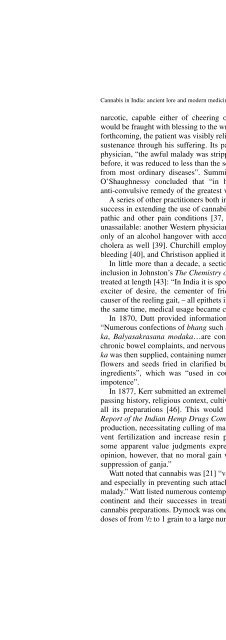3. Umbruch 4.4..2005 - Online Pot
3. Umbruch 4.4..2005 - Online Pot
3. Umbruch 4.4..2005 - Online Pot
Create successful ePaper yourself
Turn your PDF publications into a flip-book with our unique Google optimized e-Paper software.
Cannabis in India: ancient lore and modern medicine 7<br />
narcotic, capable either of cheering or of inducing harmless insensibility,<br />
would be fraught with blessing to the wretched patient”. Although no cure was<br />
forthcoming, the patient was visibly relieved of distress, and able to take some<br />
sustenance through his suffering. Its palliative benefit was not lost upon the<br />
physician, “the awful malady was stripped of its horrors; if not less fatal than<br />
before, it was reduced to less than the scale of suffering which precedes death<br />
from most ordinary diseases”. Summing up his experience with cannabis,<br />
O’Shaughnessy concluded that “in hemp the profession has gained an<br />
anti-convulsive remedy of the greatest value”.<br />
A series of other practitioners both in India and in Great Britain soon noted<br />
success in extending the use of cannabis to treatment of migraine, and neuropathic<br />
and other pain conditions [37, 38]. Few clinical syndromes seemed<br />
unassailable: another Western physician in India observed the alleviation not<br />
only of an alcohol hangover with accompanying headache, but the patient’s<br />
cholera as well [39]. Churchill employed cannabis to treat excessive uterine<br />
bleeding [40], and Christison applied it to childbirth [41] (reviewed in [42]).<br />
In little more than a decade, a section on cannabis was deemed worthy of<br />
inclusion in Johnston’s The Chemistry of Common Life, wherein the topic was<br />
treated at length [43]: “In India it is spoken of as the increaser of pleasure, the<br />
exciter of desire, the cementer of friendship, the laughter-mover, and the<br />
causer of the reeling gait, – all epithets indicative of its peculiar effects.” About<br />
the same time, medical usage became common in North America [44].<br />
In 1870, Dutt provided information on certain bhang preparations [45],<br />
“Numerous confections of bhang such a Kamesvara modaka, Madana modaka,<br />
Balyasakrasana modaka…are considered aphrodisiacs and are used in<br />
chronic bowel complaints, and nervous debility.” A recipe for Madana modaka<br />
was then supplied, containing numerous herbs, but with “hemp leaves with<br />
flowers and seeds fried in clarified butter, equal in weight to all the other<br />
ingredients”, which was “used in cough, chronic bowels complaints and<br />
impotence”.<br />
In 1877, Kerr submitted an extremely detailed report from Bengal encompassing<br />
history, religious context, cultivation and employment of cannabis in<br />
all its preparations [46]. This would form one source for the subsequent<br />
Report of the Indian Hemp Drugs Commission [47]. Documentation of ganja<br />
production, necessitating culling of male plants by the “ganja doctor” to prevent<br />
fertilization and increase resin production, was emphasized. Despite<br />
some apparent value judgments expressed, the author observed, “I am of<br />
opinion, however, that no moral gain whatever will be effected by the total<br />
suppression of ganja.”<br />
Watt noted that cannabis was [21] “valuable as a remedy for sick headache,<br />
and especially in preventing such attacks. It removes the nervous effects of a<br />
malady.” Watt listed numerous contemporary European physicians on the subcontinent<br />
and their successes in treating a large variety of disorders with<br />
cannabis preparations. Dymock was one such [34]: “I have given the extract in<br />
doses of from 1/2 to 1 grain to a large number of European hospital patients suf-







